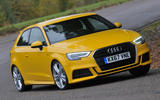For those unfamiliar with the acronym MQB, this was Volkswagen’s ultra-versatile, lightweight, part-aluminium, part-high-strength steel modular platform that it rolled out across all of its mainstream brands from 2012. It was light, strong and as easy to turn into a large saloon as a small hatchback.
For Volkswagen, Audi, Skoda and Seat its aim was to bring unprecedented economies of scale, saving the brand vast amounts of money over the lifetime of the platform.
Compared with the Mk2 Audi A3, the MQB platform shaved 80kg from the weight of the structure, improved crash safety and created more interior space.
Over it, Audi draped a shape so utterly familiar you could park it next to the secon-gen A3 and not only struggle to tell one from the other but, once your eyes had picked out the myriad of differences, still not be entirely sure which was the later car. The 2016 facelift made that process slightly easier - although only when you looked from the front - as the bonnet had sharper crease lines and the headlights had gained an unfortunate-looking extension.
The three-door A3 engine line-up featured a mix of turbocharged petrol and diesel engines. The range kicked off with a 114bhp three-cylinder 1.0-litre petrol and was topped by a 2.0 TFSI unit pushing out 197bhp, partnered with Audi's Quattro four-wheel drive system.
The 1.4 TFSI engine was dropped in favour of a higher-capacity 1.5 with lower internal friction and the ability to switch off when you are on the throttle, all to help improve efficiency but not at the expense of performance.




































